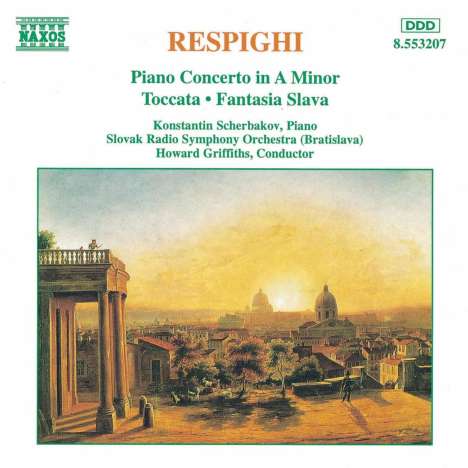Ottorino Respighi: Klavierkonzert a-moll auf CD
Klavierkonzert a-moll
Herkömmliche CD, die mit allen CD-Playern und Computerlaufwerken, aber auch mit den meisten SACD- oder Multiplayern abspielbar ist.
Lassen Sie sich über unseren eCourier benachrichtigen, falls das Produkt bestellt werden kann.
+Toccata für Klavier & Orchester; Fantasia slava für Klavier & Orchester
- Künstler:
- Konstantin Scherbakov, Slovak RSO, Howard Griffith
- Label:
- Naxos
- Aufnahmejahr ca.:
- 1994
- UPC/EAN:
- 0730099420723
- Erscheinungstermin:
- 1.6.1995
- Serie:
- Naxos 19th/20th Century Italian Classics
Ähnliche Artikel
Respighi war sicherlich einer der wichtigsten italienischen Komponisten seiner Zeit und erwarb sich auf Konzertreisen in ganz Europa und Amerika einen internationalen Ruf. Die erste der römischen symphonischen Dichtungen, die Fontane di Roma, wurde 1916 vollendet, I Pini 1924 und die Feste romane 1928. Sein Klavierkonzert in a-Moll ist ein relativ frühes Werk, das 1902 fertiggestellt wurde, und es ist daher nur folgerichtig, dass andere Einflüsse zu erkennen sind, Elemente, die auf frühere musikalische Traditionen ebenso hinweisen wie auf zeitgenössische, obwohl es einige Jahre dauerte, bis sein Interesse am gregorianischen Gesang in seinem 1921 vollendeten Concerto gregoriano für Violine und Orchester und seinem vier Jahre später vollendeten Concerto in modo misolidio für Klavier und Orchester direkten Ausdruck fand. Das Klavierkonzert beginnt mit einer grandiosen Entfaltung, bevor weiteres lyrisches Material eingeführt wird. Das Klavierkonzert ist oft blumig, idiomatisch und anspruchsvoll, in einer Musik, die durch und durch romantischen Charakter hat und in einen ruhigeren Mittelteil übergeht, dessen Heiterkeit durch den Ausbruch, der den letzten Teil des Werkes markiert, erschüttert wird, ein dramatisches Finale, das seine eigenen Momente der Ruhe und der Bravour bringt.
Respighis Toccata für Klavier und Orchester entstand 1928, im Jahr der Feste romane, drei Jahre nach dem Concerto in modo misolidio. Es gibt eine eindrucksvolle Eröffnung, die in ihren abrupt punktierten Rhythmen unvermeidliche Barock-Anklänge birgt, mit der Einführung eines weniger charakteristischen melodischen Elements, insbesondere von einem Solo-Cello im Dialog mit dem Klavier, gefolgt von Material eindeutig modaler Natur. Es gibt eine Passage von tief empfundener Melancholie im Herzen des Werkes, vor den brillanten Klaviersequenzen, die den kraftvollen Schlussteil einleiten, der mit seiner Kadenz und Figuration eine Verwandlung des barocken sequenziellen Passagenwerks suggeriert.
Die Fantasia Slava für Klavier und Orchester wurde 1903 fertiggestellt und könnte natürlich etwas von Respighis Aufenthalt in St. Petersburg und der kurzen Studienzeit bei Rimsky-Korsakow widerspiegeln. Die Fantasia Slava beginnt mit einer typisch slawischen Melodie, bevor das Soloklavier eintritt. Tänzerische Elemente erscheinen, im Zusammenspiel von Klavier und Orchester, mit mehr theatralischem Material und pianistischen Passagen, über denen manchmal der Geist Rachmaninovs schwebt.
Product Information
Respighi was certainly one of the most important Italian composers of his time and won for himself an international reputation in concert tours throughout Europe and in America. The first of the Roman symphonic poems, the Fontane di Roma, was completed in 1916, with I Pini completed in 1924 and the Feste romane in 1928. His Piano Concerto in A minor is a relatively early work, completed in 1902, and it is therefore natural that other influences should be apparent, elements that suggest earlier musical practices as much as contemporary, although it was some years before his interest in Gregorian chant found direct expression in his Concerto gregoriano for violin and orchestra, completed in 1921, and his Concerto in modo misolidio for piano and orchestra, completed four years later. The Piano Concerto opens with a grandiose flourish, before more lyrical material is introduced. The piano-writing is often florid, idiomatic and demanding, in music that is thoroughly romantic in character, moving to a calmer central section, its serenity shattered by the outburst that marks the final section of the work, a dramatic finale, that brings its own moments of repose and of bravura.
Respighi's Toccata for piano and orchestra was written in 1928, the year of Feste romane, three years after the Concerto in modo misolidio. There is an impressive opening that has inevitable echoes of the Baroque in its abruptly dotted rhythms, with the introduction of a less characteristic melodic element, notably from a solo cello in dialogue with the piano, followed by material of a clearly modal nature. There is a passage of deeply felt melancholy at the heart of the work, before the brilliant piano sequences that introduce the vigorous final section, with its cadenza and figuration suggesting a transmutation of Baroque sequential passage-work.
The Fantasia Slava for piano and orchestra was completed in 1903 and might naturally be supposed to reflect something of Respighi's stay in St Petersburg and the brief period of study with Rimsky-Korsakov. The Fantasia opens with a typically Slav melody, before the entry of the solo piano. Dance elements appear, in interplay between piano and orchestra, with more histrionic material and passages of pianistic display, over which the spirit of Rachmaninov sometimes hovers.
Rezensionen
A. Csampai in stereoplay 11/95: "..handelt es sich um eine musikalisch überzeugende Ausgrabung. Die Leistungen des technisch perfekten Pianisten bewegen sich auf absolutem Weltklasse-Niveau."Disk 1 von 1 (CD)
-
1 Piano Concerto in A minor, P. 40: Concerto for Piano and Orchestra in A minor
-
2 Toccata for Piano and Orchestra
-
3 Fantasia Slava for Piano and Orchestra
Mehr von Ottorino Respighi
-
Ottorino RespighiAntiche Danze ed Arie per LiutoSuper Audio CDVorheriger Preis EUR 18,99, reduziert um 0%Aktueller Preis: EUR 7,99
-
Ottorino RespighiMarie Victoire3 CDsVorheriger Preis EUR 29,99, reduziert um 0%Aktueller Preis: EUR 14,99
-
Ottorino RespighiMetamorphoseon Modi XIISuper Audio CDAktueller Preis: EUR 19,99
-
Ottorino RespighiTrittico BotticellianoSuper Audio CDAktueller Preis: EUR 19,99









